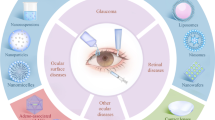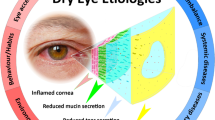Abstract
Purpose of Review
To focus on new medical therapies that lower intraocular pressure in glaucoma.
Recent Findings
We summarize new classes of medications to help treat open-angle glaucoma and ocular hypertension, including modified prostaglandin analogues, such as latanoprostene bunod, and prostanoid receptor agonists, ONO-9054 and DE-117. We summarize the differences among the Rho kinase inhibitors that modulate the actin cytoskeleton. We present preclinical and clinical data on the adenosine receptor agonist, trabodenoson, and the RNAi-based compound, bamosiran.
Summary
Several promising drugs with novel mechanisms of action are in development to lower intraocular pressure in glaucoma. The Food and Drug Administration approved latanoprostene bunod and netasurdil for commercial use in late 2017. These drugs mark the first new compounds to treat glaucoma in over two decades.

Similar content being viewed by others
References
Papers of particular interest, published recently, have been highlighted as: • Of importance
Quigley HA, Broman AT. The number of people with glaucoma worldwide in 2010 and 2020. Br J Ophthalmol. 2006;90:262–7.
Weinreb RN, Aung T, Medeiros FA. The pathophysiology and treatment of glaucoma: a review. JAMA : the journal of the American Medical Association. 2014;311:1901–11.
Boland MV, Ervin AM, Friedman DS, Jampel HD, Hawkins BS, Vollenweider D, et al. Comparative effectiveness of treatments for open-angle glaucoma: a systematic review for the U.S. Preventive Services Task Force. Ann Intern Med. 2013;158:271–9.
Krauss AHP, Impagnatiello F, Toris CB, Gale DC, Prasanna G, Borghi V, et al. Ocular hypotensive activity of BOL-303259-X, a nitric oxide donating prostaglandin F2α agonist, in preclinical models. Exp Eye Res. 2011;93:250–5.
• Schuman JS, Erickson K, Nathanson JA. Nitrovasodilator effects on intraocular pressure and outflow facility in monkeys. Exp Eye Res. 1994;58:99–105. This is one of the first papers to demonstrate that nitrovasodilators can decrease intraocular pressure and increase outflow facility in vivo in a primate model.
• Nathanson JA, McKee M. Identification of an extensive system of nitric oxide-producing cells in the ciliary muscle and outflow pathway of the human eye. Investigative Ophthalmol Visual Sci. 1995;36:1765–73. This paper described the sites of nitric oxide synthesis in the human outflow pathway using postmortem human eyes. This paper provides further evidence that nitric oxide may be used to modulate outflow resistance.
Pasquale LR. Vascular and autonomic dysregulation in primary open-angle glaucoma. Curr Opin Ophthalmol. 2016;27:94–101.
Weinreb RN, Ong T, Scassellati Sforzolini B, Vittitow JL, Singh K, Kaufman PL, et al. A randomised, controlled comparison of latanoprostene bunod and latanoprost 0.005% in the treatment of ocular hypertension and open angle glaucoma: the VOYAGER study. Br J Ophthalmol. 2015;99:738–45.
• Weinreb RN, Scassellati Sforzolini B, Vittitow J, Liebmann J. Latanoprostene bunod 0.024% versus timolol maleate 0.5% in subjects with open-angle glaucoma or ocular hypertension: the APOLLO study. Ophthalmology. 2016;123:965–73. This phase III clinical trial demonstrated that latanoprostene bunod 0.024% was noninferior to timolol 0.5%.
• Medeiros FA, et al. Comparison of Latanoprostene Bunod 0.024% and Timolol Maleate 0.5% in open-angle glaucoma or ocular hypertension: the LUNAR study. Am J Ophthalmol. 2016;168:250–9. This phase III clinical trial also demonstrated that latanoprostene bunod 0.024% was noninferior to timolol 0.5%.
Kawase K, Vittitow JL, Weinreb RN, Araie M. Long-term safety and efficacy of latanoprostene bunod 0.024% in Japanese subjects with open-angle glaucoma or ocular hypertension: the JUPITER study. Adv Ther. 2016;33:1612–27.
Toris CB, Gabelt BT, Kaufman PL. Update on the mechanism of action of topical prostaglandins for intraocular pressure reduction. Surv Ophthalmol. 2008;53(Suppl1):S107–20.
Miller Ellis E, Berlin MS, Ward CL, Sharpe JA, Jamil A, Harris A. Ocular hypotensive effect of the novel EP3/FP agonist ONO-9054 versus Xalatan: results of a 28-day, double-masked, randomised study. Br J Ophthalmol. 2017;101:796–800.
Ihekoromadu, N., et al. Safety and efficacy of DE-117, a selective EP2 agonist in a phase 2a study. in Investigative ophthalmology & visual science (2015).
Kim J, Kudisch M, Mudumba S, Asada H, Aya-Shibuya E, Bhisitkul RB, et al. Biocompatibility and pharmacokinetic analysis of an intracameral polycaprolactone drug delivery implant for glaucoma. Invest Ophthalmol Vis Sci. 2016;57:4341–6.
Honjo M, Tanihara H, Inatani M, Kido N, Sawamura T, Yue BY, et al. Effects of rho-associated protein kinase inhibitor Y-27632 on intraocular pressure and outflow facility. Invest Ophthalmol Vis Sci. 2001;42:137–44.
• Rao PV, Deng PF, Kumar J, Epstein DL. Modulation of aqueous humor outflow facility by the rho kinase-specific inhibitor Y-27632. Investigative Ophthalmol Visual Sci. 2001;42:1029–37. This preclinical study elucidated the role of rho/rho kinase signaling pathway in the modulation of aqueous humor outflow facility. Furthermore, inactivation of rho kinase by Y-27632 increased outflow facility in a porcine perfusion model.
Van de Velde S, De Groef L, Stalmans I, Moons L, Van Hove I. Towards axonal regeneration and neuroprotection in glaucoma: rho kinase inhibitors as promising therapeutics. Prog Neurobiol. 2015;131:105–19.
Inazaki H, Kobayashi S, Anzai Y, Satoh H, Sato S, Inoue M, et al. One-year efficacy of adjunctive use of ripasudil, a rho-kinase inhibitor, in patients with glaucoma inadequately controlled with maximum medical therapy. Graefes Arch Clin Exp Ophthalmol. 2017;255:2009–15.
Isobe T, Mizuno K, Kaneko Y, Ohta M, Koide T, Tanabe S. Effects of K-115, a rho-kinase inhibitor, on aqueous humor dynamics in rabbits. Curr Eye Res. 2014;39:813–22.
Tanihara H, Inoue T, Yamamoto T, Kuwayama Y, Abe H, Araie M, et al. Phase 2 randomized clinical study of a rho kinase inhibitor, K-115, in primary open-angle glaucoma and ocular hypertension. Am J Ophthalmol. 2013;156:731–6.
Tanihara H, Inoue T, Yamamoto T, Kuwayama Y, Abe H, Suganami H, et al. Additive intraocular pressure-lowering effects of the rho kinase inhibitor ripasudil (K-115) combined with timolol or latanoprost: a report of 2 randomized clinical trials. JAMA ophthalmology. 2015;133:755–61.
Kiel JW, Kopczynski CC. Effect of AR-13324 on episcleral venous pressure in Dutch belted rabbits. Journal of ocular pharmacology and therapeutics : the official journal of the Association for Ocular Pharmacology and Therapeutics. 2015;31:146–51.
Wang RF, Williamson JE, Kopczynski C, Serle JB. Effect of 0.04% AR-13324, a ROCK, and norepinephrine transporter inhibitor, on aqueous humor dynamics in normotensive monkey eyes. J Glaucoma. 2015;24:51–4.
Bacharach J, Dubiner HB, Levy B, Kopczynski CC, Novack GD. Double-masked, randomized, dose-response study of AR-13324 versus latanoprost in patients with elevated intraocular pressure. Ophthalmology. 2015;122:302–7.
• Serle JB, Katz LJ, McLaurin E, Heah T, Ramirez-Davis N, Usner DW, et al. Two Phase 3 clinical trials comparing the safety and efficacy of netarsudil to timolol in patients with elevated intraocular pressure: rho kinase elevated IOP treatment trial 1 and 2 (ROCKET-1 and ROCKET-2). Am J Ophthalmol. 2018;186:116–27. This paper presented results from two phase III trials comparing netarsudil 0.02% to timolol 0.5%. One of the studies, ROCKET-2, demonstrated that netarsudil dosed daily and twice daily were noninferior to timolol.
Lewis RA, Levy B, Ramirez N, C Kopczynski C, Usner DW, Novack GD, et al. Fixed-dose combination of AR-13324 and latanoprost: a double-masked, 28-day, randomised, controlled study in patients with open-angle glaucoma or ocular hypertension. Br J Ophthalmol. 2016;100:339–44.
Van de Velde S, et al. AMA0076, a novel, locally acting rho kinase inhibitor, potently lowers intraocular pressure in New Zealand white rabbits with minimal hyperemia. Invest Ophthalmol Vis Sci. 2014;55:1006–16.
Hall, J., et al. Initial clinical evaluation of safety, tolerability and pharmacodynamics of the locally-acting ROCK inhibitor AMA0076 in Investigative ophthalmology & visual science, Vol 55 (2014).
Multiple Dose-parallel-group Study of AMA0076 in patients with primary open-angle glaucoma or ocular hypertension. (Clinicaltrials.gov).
Multiple Dose-escalation Study of AMA0076 in patients with ocular hypertension or primary open-angle glaucoma. (Clinicaltrials.gov).
Peterson JA, Tian B, Geiger B, Kaufman PL. Effect of latrunculin-B on outflow facility in monkeys. Exp Eye Res. 2000;70:307–13.
Rasmussen CA, Kaufman PL, Ritch R, Haque R, Brazzell RK, Vittitow JL. Latrunculin B reduces intraocular pressure in human ocular hypertension and primary open-angle glaucoma. Translational vision science & technology. 2014;3:1.
Crosson CE, Sloan CF, Yates PW. Modulation of conventional outflow facility by the adenosine A1 agonist N6-cyclohexyladenosine. Invest Ophthalmol Vis Sci. 2005;46:3795–9.
Shearer, T.W. & Crosson, C.E. Adenosine A1 receptor modulation of MMP-2 secretion by trabecular meshwork cells. Investigative ophthalmology & visual science 43, 3016–3020 (2002).
Myers JS, Sall KN, DuBiner H, Slomowitz N, McVicar W, Rich CC, et al. A dose-escalation study to evaluate the safety, tolerability, pharmacokinetics, and efficacy of 2 and 4 weeks of twice-daily ocular trabodenoson in adults with ocular hypertension or primary open-angle glaucoma. Journal of ocular pharmacology and therapeutics : the official journal of the Association for Ocular Pharmacology and Therapeutics. 2016;32:555–62.
Inotek announces top-line results for MATrX-1, first phase 3 trial of trabodenoson for glaucoma. (Business Wire, 2017).
Inotek Pharmaceuticals announces top-line results of phase 2 fixed-dose combination trial of trabodenoson and provides corporate update. (Business Wire, 2017).
• Martinez T, et al. In vitro and in vivo efficacy of SYL040012, a novel siRNA compound for treatment of glaucoma. Mol Ther: J Am Soc Gene Ther. 2014;22:81–91. This preclinical study demonstrated that SYL040012, a novel siRNA compound, reduces ADRB2 expression in cell cultures and eye tissues. The paper also demonstrated that the drug reduced intraocular pressure in both normotensive and hypertensive animal models.
Gonzalez, V., et al. Phase 2 of bamosiran (SYL040012), a novel RNAi based compound for the treatment of increased intraocular pressure associated to glaucoma. in Investigative ophthalmology & visual science, Vol. 55 (2014).
Author information
Authors and Affiliations
Corresponding author
Ethics declarations
Conflict of Interest
Catherine Q. Sun declares that she has no conflicts of interest. Yvonne Ou is a consultant for Merck Research Laboratories.
Human and Animal Rights and Informed Consent
This article does not contain any studies with human or animal subjects performed by any of the authors.
Additional information
This article is part of the Topical Collection on Diagnosis and Monitoring of Glaucoma
Rights and permissions
About this article
Cite this article
Sun, C.Q., Ou, Y. New Developments in the Medical Treatment of Glaucoma. Curr Ophthalmol Rep 6, 73–78 (2018). https://doi.org/10.1007/s40135-018-0166-3
Published:
Issue Date:
DOI: https://doi.org/10.1007/s40135-018-0166-3




